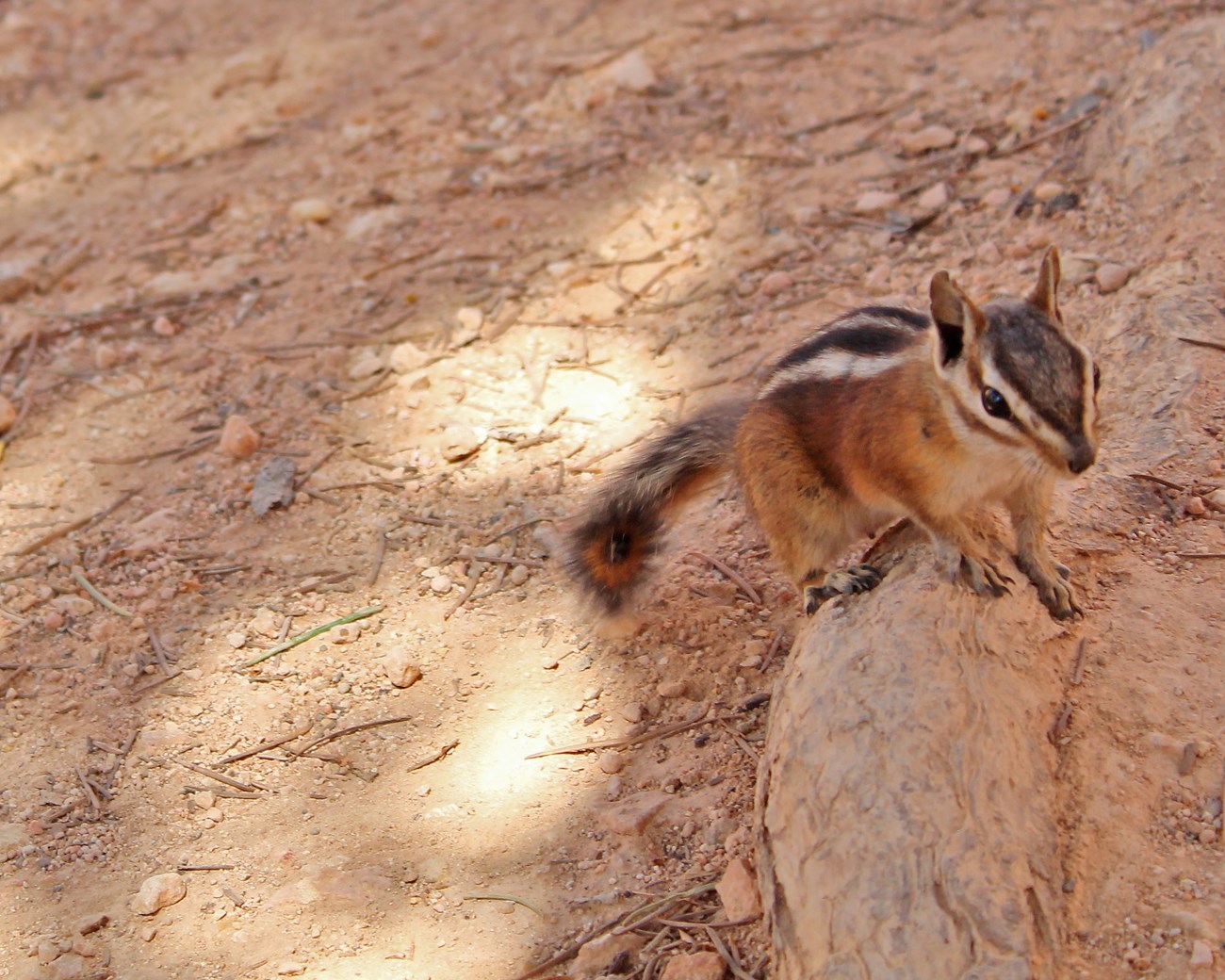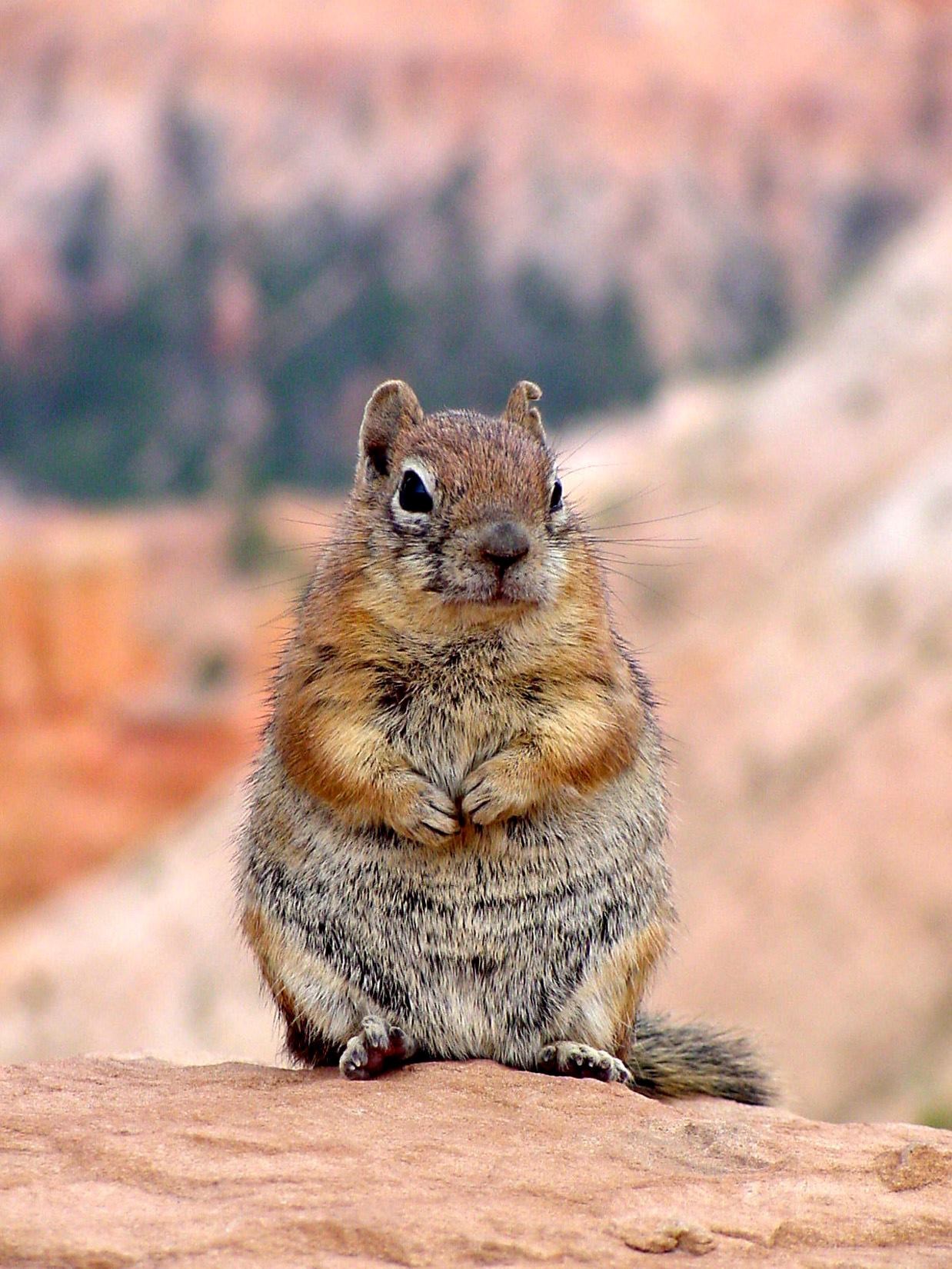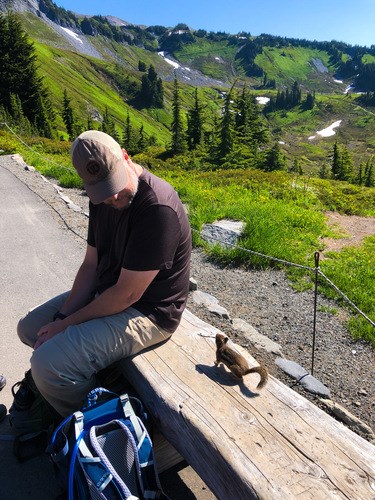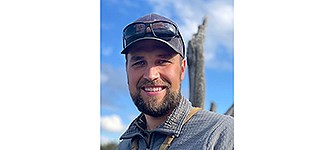Last updated: March 7, 2025
Article
Who Is the Bad Guy Here? When Animals Misbehave
When it comes to wildlife mischief, we have found the biggest troublemaker, and it is us.
By Nicole Frey and Chad Wildermuth

Image © Nicki Frey
In 2013, Bryce Canyon National Park had a problem: animals were living in the attics of the park’s historic cabins.
I (Frey) help fix conflicts between people and animals, like rabbits in your garden or deer eating your shrubs. I had helped Zion National Park when they had ringtails—small, racoon-like mammals—living in the park’s lodge. The staff at Bryce Canyon knew this, so they gave my colleague (Wildermuth) and me a call. We discovered nests of small mammals like chipmunks, wood rats, and ringtails in nearly every attic. Getting and keeping the animals out was only one part of the solution, because the real problem was something we didn’t expect: people were feeding them.
But who was doing this, and why? There were strong “don’t feed the wildlife” messages throughout the park. Through direct observation and survey questionnaires, we studied how park visitors interacted with wildlife. We discovered that the type of animal and its location had the greatest influence on whether human-wildlife conflicts occurred. And those visitors who wanted to see or photograph animals were more likely to view interacting with them as appropriate.
An Uneasy Coexistence
U.S. national parks are special areas set aside to protect resources and provide for public recreation. They’re popular places for people to observe wildlife. But sometimes the actions of park visitors not only change the natural environment of animals but also influence their behavior.
Visitors’ actions can change where animals spend their time or when they eat or sleep.
Visitors’ actions can change where animals spend their time or when they eat or sleep. Animals like bighorn sheep, with very specific habitat or food requirements, show less tolerance for disturbance and can be more affected by people recreating. Others, like coyotes, can live anywhere and eat a lot of different things. They may become used to being around people—habituated—which can increase opportunities for conflict.

Image courtesy of the Sequoia & Kings Canyon National Parks Historic Image Collection
People’s interactions with larger animals like bears often get a lot of media attention. In the past, it was common practice for visitors to feed black bears in national parks, causing them to become food-conditioned—reliant on garbage and other sources of human food. And bears in wildland areas near towns still do. This can result in increased aggression toward humans. But small mammals like rodents and racoons account for the largest number of human-wildlife conflicts recorded in the United States annually. These conflicts may result in people sustaining minor injuries, infections, and disease, such as rabies, plague, which prairie dogs can transmit, and hantavirus pulmonary syndrome from deer mice and other rodents. Cases of these have drawn national attention to the risks of interacting with disease-infected animals in national parks.
These conflicts may result in people sustaining minor injuries, infections, and disease, such as rabies.
In light of outbreaks of zoonotic diseases—those transmitted from animals to humans—in western U.S. national parks, our findings in Bryce Canyon’s historic cabins prompted us to investigate human-wildlife interactions in the park. We examined how frequently negative interactions—any interaction between an animal and a person that hurts or disturbs either of them—occurred, what species of animals were involved, and where most conflicts happened.
Anonymous Observations
Most wild animals avoid direct contact with people most of the time. But if they’ve learned through habituation that the risk to their well-being is low, wildlife can learn to tolerate being around people. When an animal thinks that the risk of being around people is worth the reward, especially when food is involved, they’ll be attracted to humans and human activity.
Over 1.7 million people visited Bryce Canyon National Park in 2014, the year of our study. Visitation peaked at around 300,000 visitors per month from June to August, and the park remained busy from April to October. Although Bryce Canyon has about 50 miles of trails, most hikers remained within the main amphitheater between Sunrise Point and Bryce Point on the Queen’s Garden, Navajo Loop, or Peekaboo Loop trails and connectors. These trails make up only nine and a half miles of the 50-mile park trail system, creating an uneven distribution of people in the park. Animals that want to avoid people wouldn’t frequent these popular areas, but animals that are habituated or attracted to humans would.

Image credit: NPS
We selected eight locations throughout the park to study human-wildlife interactions: Fairyland Point, Sunrise Point, Bryce Canyon Lodge, Sunset Point, Navajo Loop, Inspiration Point, Bryce Point, and Rainbow Point. These are the most popular trails and overlooks in the park, so we expected that conflicts would most likely occur there. We designated eight distinct one-hour time blocks throughout the day as sampling periods, avoiding the hot midday hours. We randomly paired these time blocks and locations to create a sampling schedule and assigned each time block–location pair to one day of the week. We observed human-wildlife interactions from May through August 2014, when visitation rates were highest.
To avoid influencing the outcome, we remained anonymous and didn’t interact with visitors during the study.
For each one-hour observation period, we occupied an unobtrusive place with a good view of the location. To avoid influencing the outcome, we remained anonymous and didn’t interact with visitors during the study. We observed every interaction between humans and wildlife, recording things like species and number of animals, number of visitors, presence of interpretive signs, and type of interaction. Sometimes a person or group we were observing had multiple encounters with wildlife. When this happened, we only recorded the first interaction. But if one animal interacted with multiple visitors or groups, we recorded all those interactions.
What’s a “Conflict”?
McKenzie Petrie, a member of the search and rescue team at Bryce Canyon National Park, said that during her patrols, she had to “politely ask a few Bryce Canyon visitors to not feed the squirrels that awaited a treat in the park.” Although most people listened, some didn’t. Petrie’s experiences underscore what’s often at the heart of human-wildlife interactions: intentional or inadvertent feeding.
We considered all behaviors except “respect” as conflicts and inappropriate.
For our study, we defined an interaction as when the animal, the person, or both acknowledged the other’s presence. For example, visitors kneeling to photograph a chipmunk or pointing out a bird in the tree above their picnic table were typical interactions where the person acknowledged the animal. A ground squirrel running from a trail into the brush as visitors approached or a raven flying down to land next to a parked car with visitors eating lunch were examples of animals acknowledging people. We placed human-wildlife interactions into one of seven categories:
-
Respect - the animal and the visitor tolerated each other for a brief time and didn’t directly approach each other or engage in inappropriate activities. For example, if a bird continued eating in the bushes while visitors noticed it but kept walking by, we considered this “respect.”
-
Fear - The visitor yelled at or “shooed” the animal or ran away.
-
Pursue - the visitor pursued the animal after the initial encounter, with the animal avoiding, showing alarm, or running away from the visitor.
-
Steal – the animal stole food from the visitor without provocation.
-
Beg – the animal approached the visitor within two meters (about 6.5 feet) and displayed begging behavior.
-
Feed – the visitor intentionally fed the animal.
-
Indirect feed – the animal ate scraps left behind by a visitor seen earlier during the observation period.
We considered all behaviors except “respect” as conflicts and inappropriate, as they were potentially harmful to people or wildlife, even when they occurred without the visitor’s knowledge.

Image credit: NPS
Squirrely Interactions
We recorded 327 observations from May to August 2014. After an initial look at the data, we saw that Fairyland Point and Bryce Canyon Lodge had too few interactions to predict which factors contribute to conflicts. And most animal interactions were with golden-mantled ground squirrels, Steller’s jays, common ravens, chipmunks, Clark’s nutcrackers, American robins, and mule deer. We didn’t analyze interactions between people and animals who encountered them infrequently, such as black bears. This meant removing six observations from the dataset, leaving 321 for us to analyze.
More than 27 percent of interactions were conflicts, from 12 percent at Inspiration Point to 48 percent at Navajo Loop. Navajo Loop also had the highest number of interactions (104). The lowest number of interactions occurred at Sunrise Point (12). Golden-mantled ground squirrels had the highest number of total interactions with visitors (138) and the highest percentage of conflicts of any species observed (48 percent). Steller’s jays had the second highest number of total interactions (77) but the lowest percentage of conflicts (7 percent).

Image credit: NPS / Jessica Weinberg McClosky. Data from Wildermuth,"Human-Wildlife Interactions in Bryce Canyon National Park," 2020.
Our analysis showed that some wildlife species were more prone to conflict than others. For example, ground squirrels were about five times more likely to be in a conflict than any other species. Location also played a part. Inspiration Point was about eight times less likely to have a conflict than any other site.
Species and Location Matter
In our study, only two of seven species were responsible for most of the conflicts: ground squirrels and Steller’s jays. Bryce Canyon is not alone in this; studies at Crater Lake National Park have also reported a large number of conflicts with golden-mantled ground squirrels. The prevalence of Steller’s jays on the landscape coupled with their intelligence suggest they are predisposed to begging and stealing from visitors. But our study showed otherwise; although they were the second most likely species to interact with visitors, those interactions rarely resulted in conflicts. That isn’t the case in other parks, but we don’t have the data to explain why our study results for Bryce Canyon were different.
The highest number of interactions took place at the intersection of the two most popular hikes.
The influence of location on the probability of conflict depended on the concentration of visitors and availability of human food rather than the location’s physical characteristics. The highest number of interactions took place at the intersection of the two most popular hikes in Bryce Canyon National Park: Navajo Loop and the Queens Garden Trail. This was where many hikers stopped for a break or snack.

Image © Nicki Frey
There were no trash disposal containers, and visitors sometimes left food scraps in the surrounding area. During our observations, we studied the area 50 meters (164 feet) around three benches commonly used by hikers taking a break. We suspect that over time, ground squirrels came to expect these food sources and habituated to humans. This likely led to the higher number of interactions and rates of conflict we observed along the Navajo Loop, particularly at those benches.
Some animals in our study area hadn’t habituated to people. Although we commonly observed mule deer in the park, we detected only six human-deer interactions. We didn’t see deer often where there were many people. This could be because there wasn’t a lot of food for deer in those areas. Or it could mean that deer—a naturally skittish prey species—moved away from those areas when humans were nearby. Studies in other parks have recorded mule deer running from humans when hikers are 300 ft away and shifting their activities to the night, when few hikers are about.
When Loving Wildlife Leads to Feeding Them
We also asked visitors to complete a questionnaire as they were leaving one of the viewpoints. Out of a total of 224 questionnaires, roughly 55 percent were answered by U.S. residents, and 45 percent by international visitors. Visitors for whom seeing and photographing wildlife were the most important activities—as was the case for international visitors—were more likely to view actions such as “get as close as you can to get a better view” and “quietly approach the animal to take a photo” as appropriate.

Image credit: NPS
About one percent of all respondents thought it was appropriate to put food on the ground for wildlife—particularly chipmunks and squirrels. Alarmingly, almost two percent of respondents thought it was appropriate to have a squirrel eat food out of their hands. Although this percentage seems low, with almost two million visitors a year in the park, that means more than 30,000 visitors felt it was okay to feed wildlife.
How to Prevent Bad Behavior
“I remember my first summer at Bryce,” said Macie Monahan, a wildlife biologist at the park. “I was on the Navajo Loop near a common rest and snack spot with benches, where I saw park visitors petting a golden-mantled ground squirrel. Park staff now use this location to give out basic park information, but also as an educational opportunity to tell park visitors when they are getting too close to wildlife and that it’s not okay to feed them.”
No matter how much people enjoy seeing wild animals, the best course of action is to keep a respectful distance.

Image credit: NPS / B. Burnett
We didn’t mark individual animals for this study. But based on our observations, we suspect only a small percentage of ground squirrels engaged in begging and stealing, accounting for most conflicts. For example, at a picnic area, instead of seeing many squirrels running around an area, finding food, and then leaving, we would observe one or two squirrels repeatedly interacting with visitors as they unpacked their bags to have a snack. Targeted messaging that addresses ground squirrels while simultaneously encouraging visitors to “Leave No Trace” could help solve the problem. We therefore suggest that efforts to reduce overall wildlife-human conflicts in Bryce Canyon focus on this species.
Certain individual animals in our study area seemed to obtain a high percentage of their daily food intake from people. This is problematic for them, as eating inappropriate food could cause their natural feeding cycles and activity patterns to change. This could adversely affect their long-term survival and bears further study. But it’s clear from our work that no matter how much people enjoy seeing wild animals in national parks, the best course of action is to keep a respectful distance.


